The foolproof guide to easy pineapple tepache, a fizzy fermented Mexican drink made from just pineapple peels, sugar, and water!
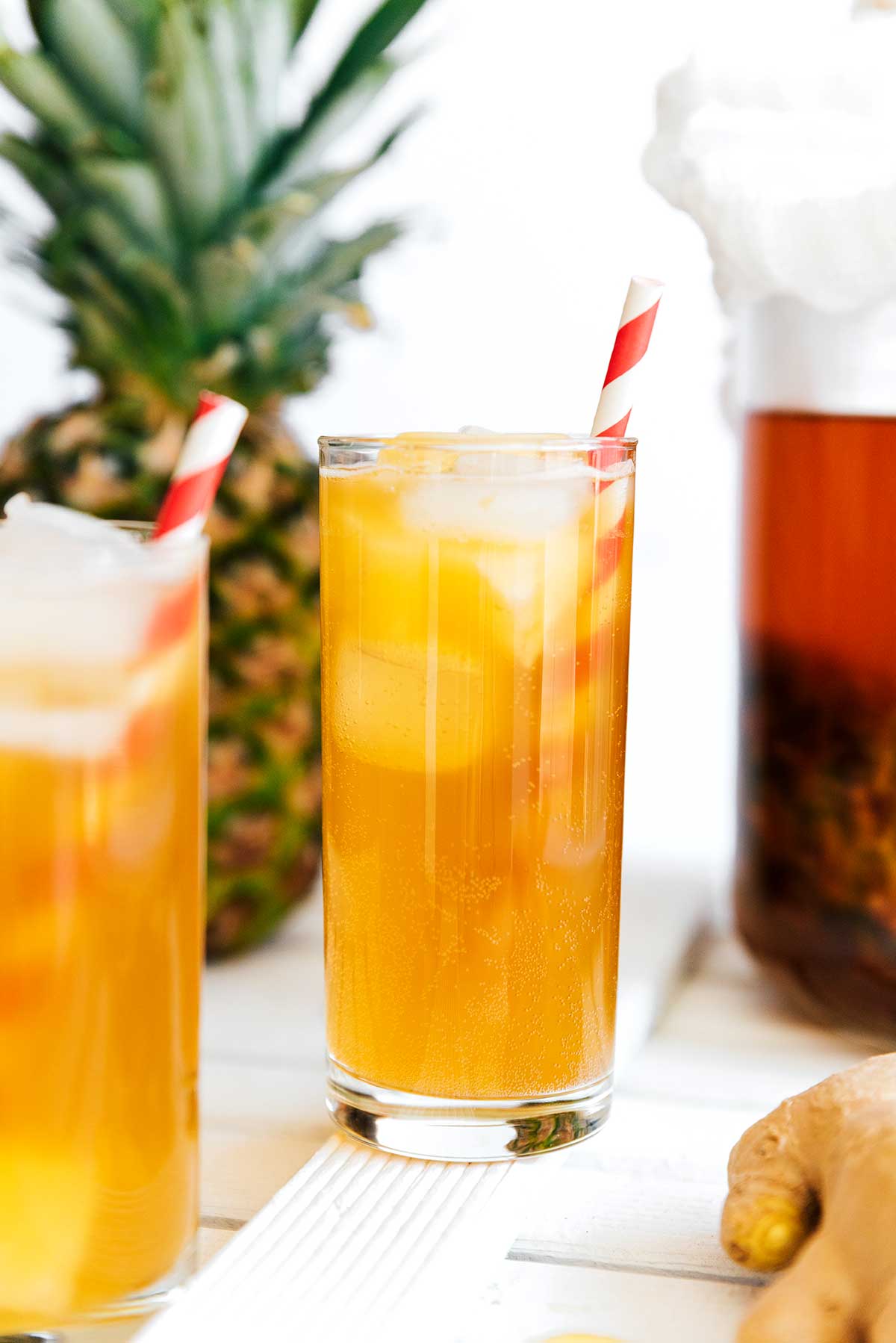
TEPACHE! Words cannot express how excited I am to finally be sharing this tepache recipe with you. So instead, I’ll just chant what I chant whenever I crack open a bangin’ bottle of tepache…
TEPACHE TEPACHE TEPACHE TEPACHE!
Ever since Brad of Bon Appetit brought tepache into my life, I’ve been working on perfecting my own recipe for this fizzy fermented brew.
You have questions, I know. Like what is tepache? (Perfection). And is it easy to make? (Heckin’ yes). So let’s brew, shall we? (You can jump around this tutorial by clicking the links below):
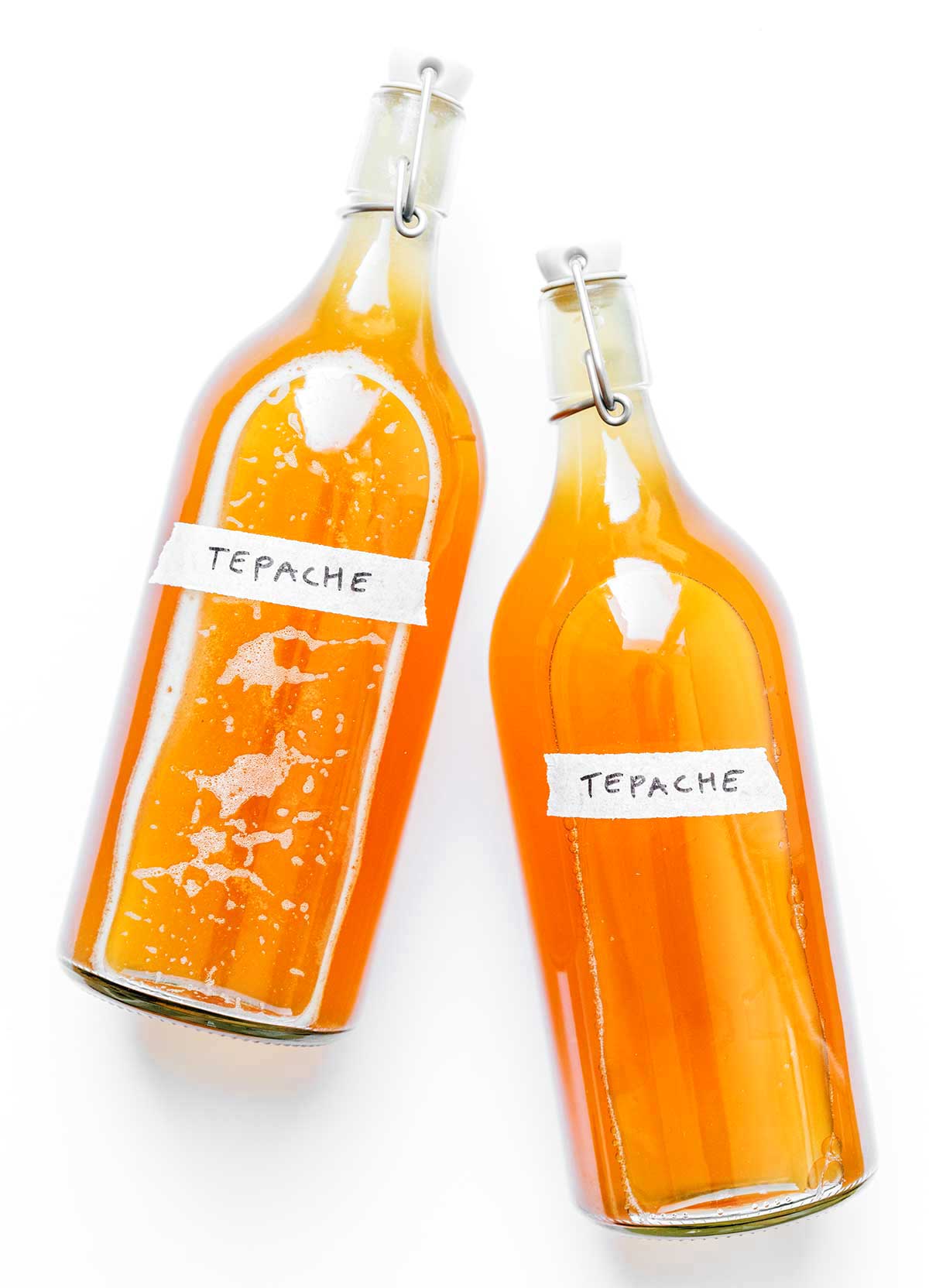
What is tepache?
Tepache, otherwise known as Tepache de Piña or pineapple beer, is a Mexican fermented drink made from the peel of pineapple.
Here’s how it works: There is yeast living virtually everywhere, and it can be harnessed to make delicious things! Yeast on flour makes sourdough, yeast on tea makes kombucha, and yeast on pineapple skin…makes tepache!
By feeding this yeast what it loves (sugar), you can use these yeast beasts to create flavor and carbonation.
So what does this pineapple brew taste like? Tepache can range from cider-like and sweet to yeasty like beer. But just as complex as the flavor is the carbonation, which gives this drink a fizzy, effervescent feel. The result is a delicious drink falling somewhere between soda, kombucha, and beer.
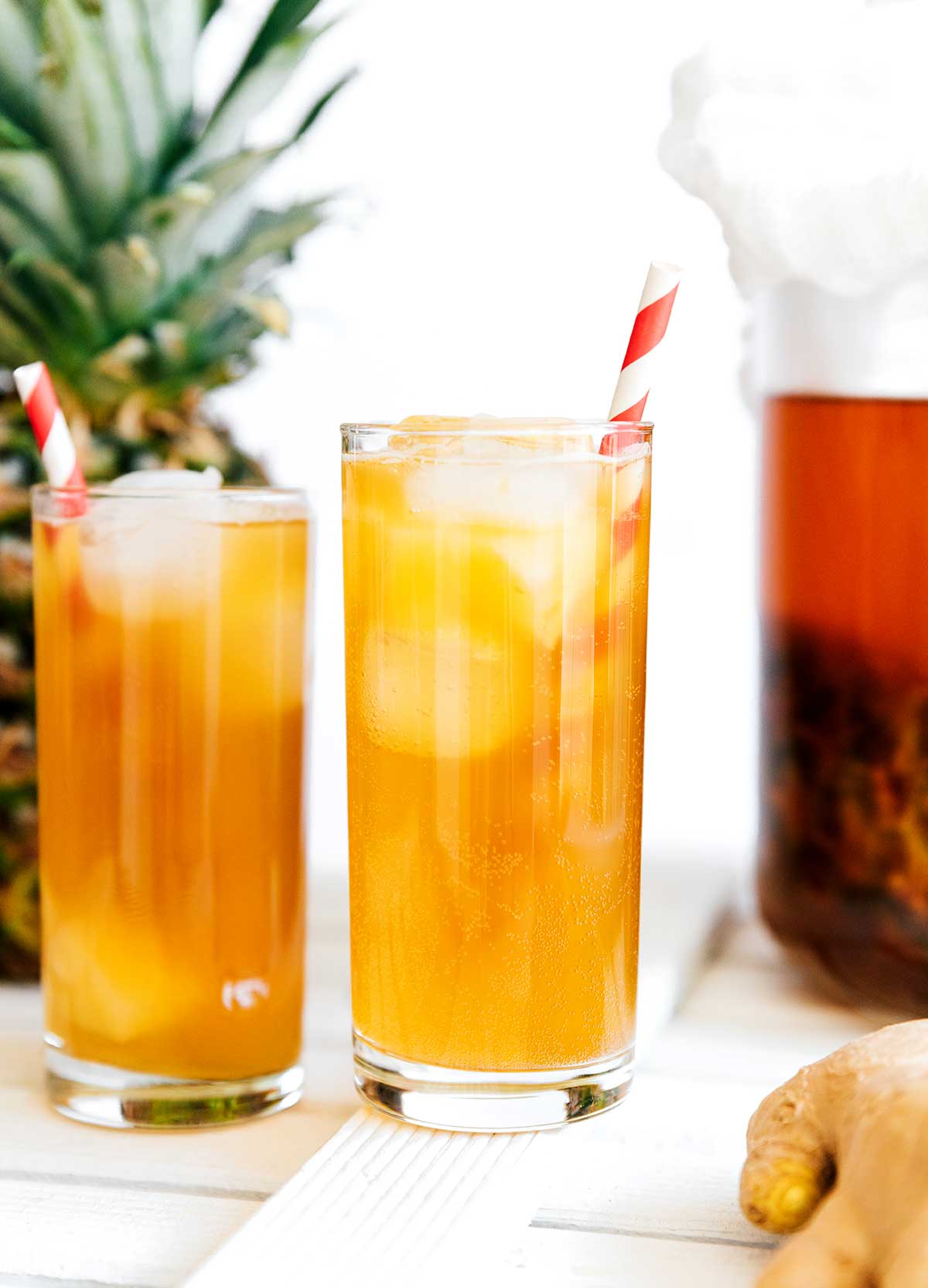
Ingredients for homemade tepache
One of the best things about tepache is how simple the ingredients are! You’ll just need:
- Pineapple Peel: Since we’re using the peel, aim for an organic pineapple. Pineapples are a pesticide intensive crop, and you don’t want that in your tepache!
- Sugar: Use either piloncillo (the traditional Mexican sugar) or light brown sugar.
- Water: No need to overcomplicate things – tap water is just fine here!
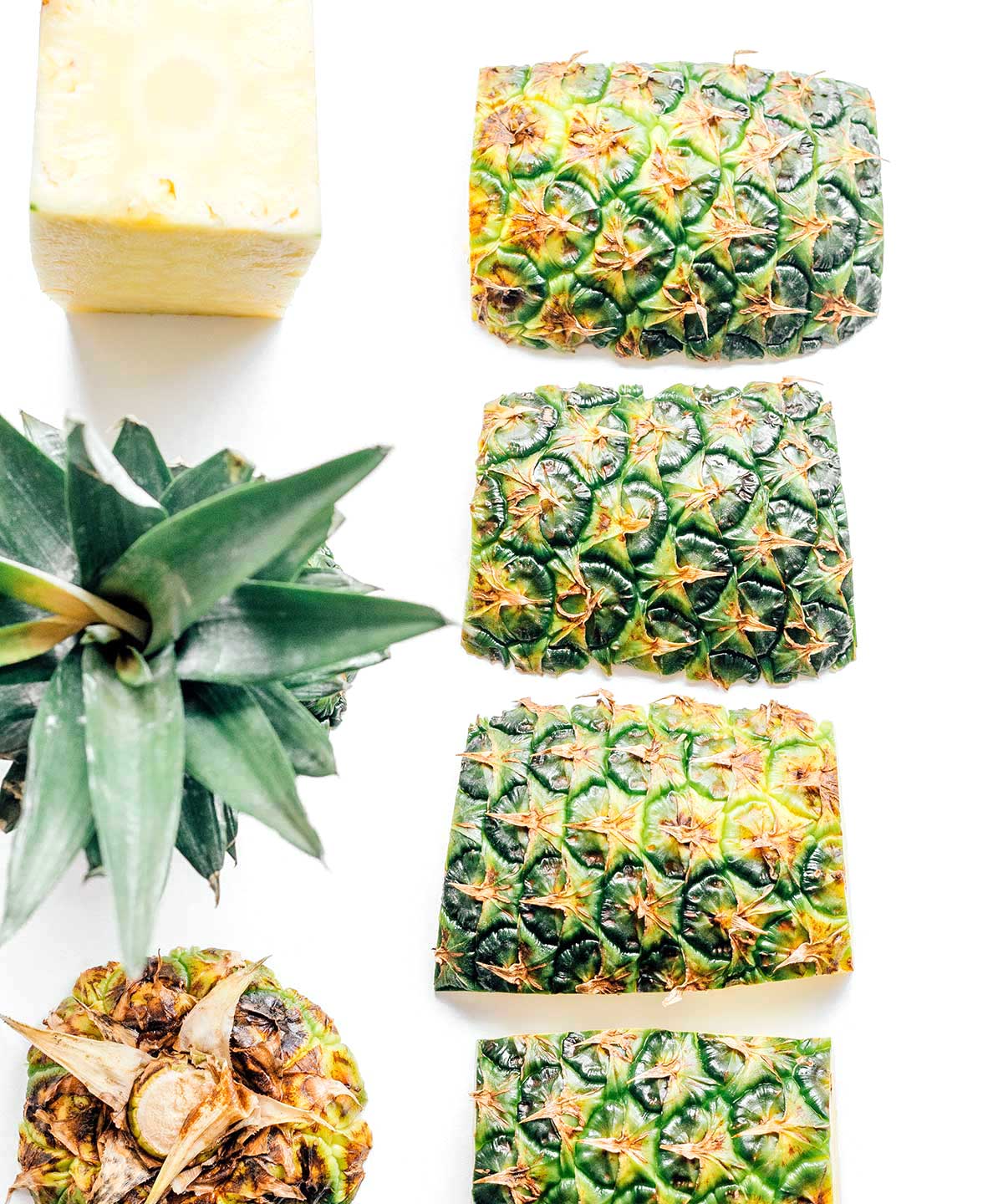
How to Make Tepache
To go with our easy list of ingredients, it’s also incredible easy to make. Here’s how to make tepache, step-by-step!
Step 1: Cut the Pineapple
Remove the crown and base of the pineapple, then rinse the body of the pineapple with cool tap water to remove potential pests or dirt. Cut the peel from the pineapple in big chunks, leaving about ½ inch of the pineapple flesh on the peel.
Step 2: Assemble
To a clean, large glass or ceramic jar, add light brown sugar (or piloncillo) and some water, stirring well to dissolve the sugar. Add pineapple rinds, then cover with remaining water. The pineapple will need to be submerged in the liquid to prevent mold, so weigh it down using either a glass, spoon, or fermentation weight.
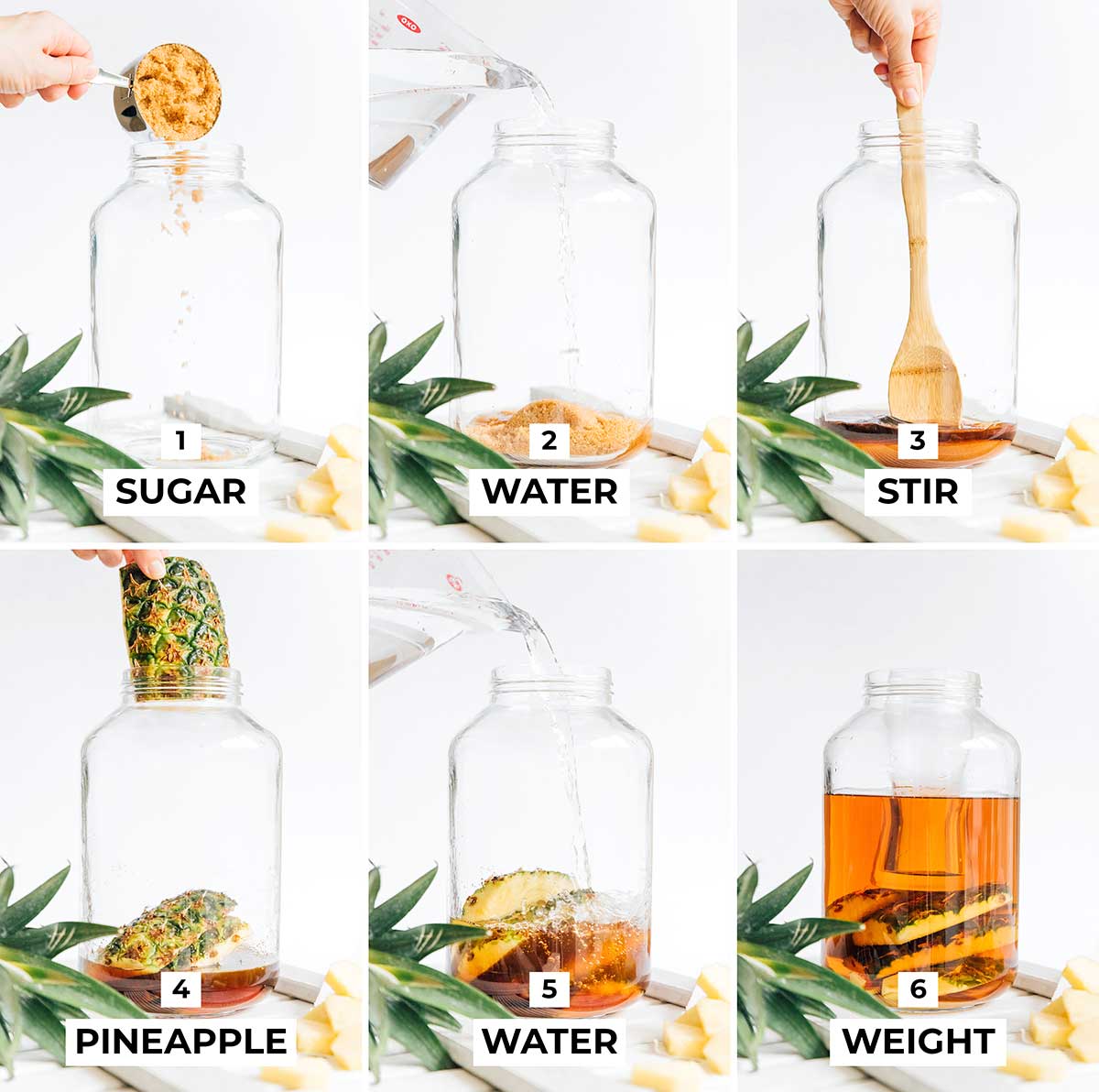
Step 3: Ferment
Cover with a clean dish towel or a few layers of paper towels, then secure with a rubber band. This will keep out pesky gnats or flies while allowing the yeasts to have oxygen. Set somewhere dark and room temperature (ideally 75-80°F, 24-26°C), letting it ferment for 1 to 3 days.
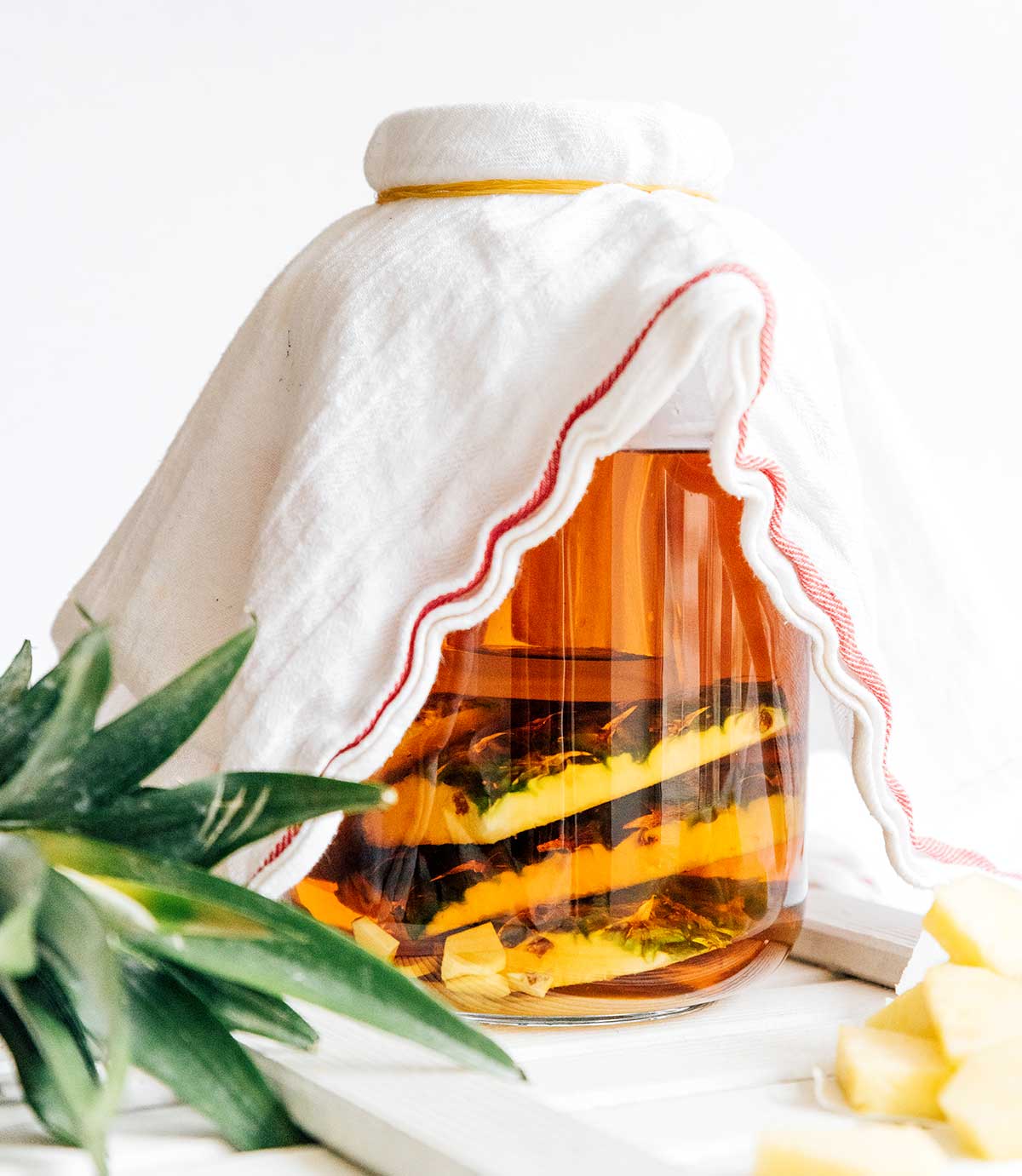
Step 4: Drink or Bottle
The tepache is finished fermenting when you see many small bubbles on top and it tastes how you want it to (test by drawing some out with a paper straw, using your finger to keep the tepache in the straw).
The longer it ferments, the less sweet and more yeast flavored it will become. The reaction will go more quickly in a warm environment, and will slow down when it is cooler, so begin tasting after 24 hours, letting the fermentation run for up to 72 hours.
At this point, you can either refrigerate and drink the tepache as it is, or carbonate it by bottling the liquid in what we call the second fermentation.
Pro-tip: There is still yeast left on your pineapple peels, so you can reuse them for one or two more rounds!
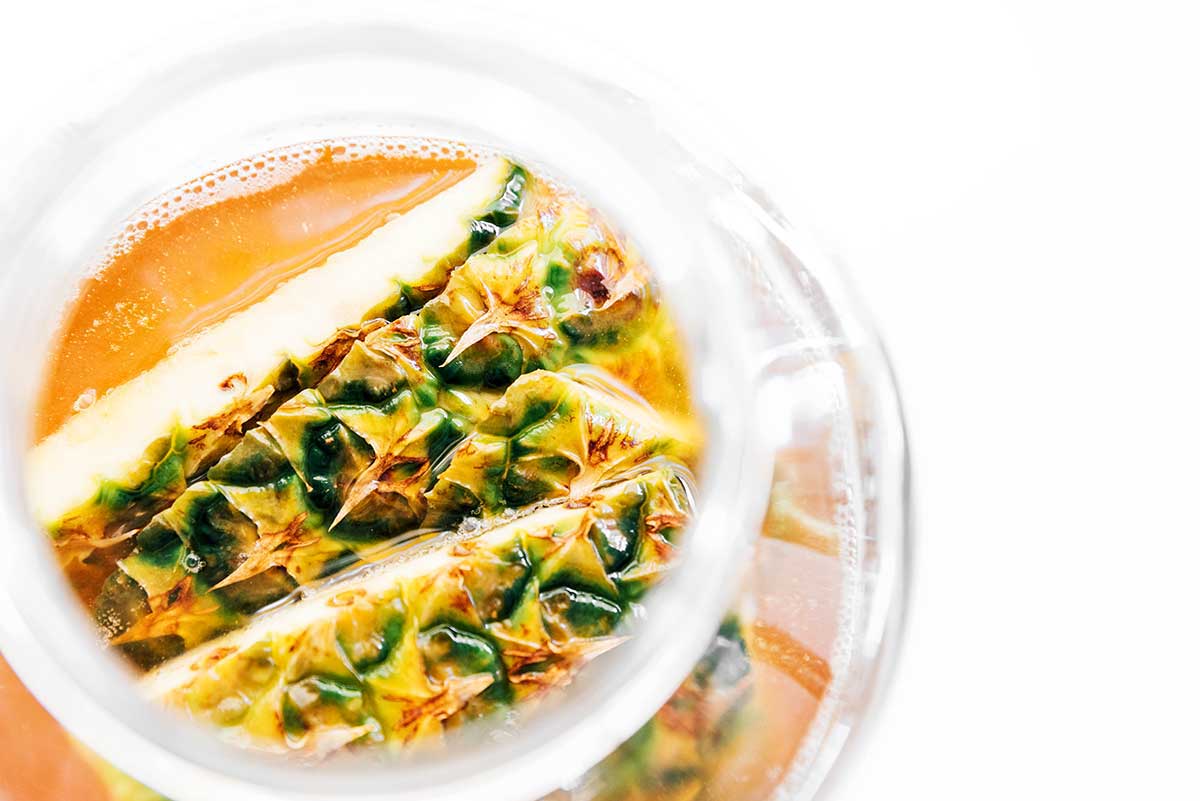
Second Fermentation
Much like in brewing kombucha, the second fermentation is an optional step used to add carbonation (and sometimes flavor) to your drink.
By bottling the tepache in an air tight container, all the CO2 released by the yeast is trapped in the liquid, creating that fizzy, beer-like texture. Which brings us to the final step of making tepache:
Step 5: Second Fermentation (optional, but recommended)
Funnel the liquid into fermentation-grade bottles (I recommend these bottles), leaving about 2 inches free at the top of each bottle. Set somewhere room temperature and dark, then allow it to ferment for another 1 to 3 days. After 24 hours, pop open a bottle to see how carbonated it has become and to gauge how much longer they will need. When the tepache has reached a carbonation level that you like, transfer the bottles to the refrigerator to stop the fermentation.
Please note, carbonating tepache does involve pressure build up inside the bottles, which is why I recommend bottles specifically made for fermentation. As with any second fermentation, there is a risk of bottles exploding, so check on your bottles regularly and move them to the refrigerator when done.
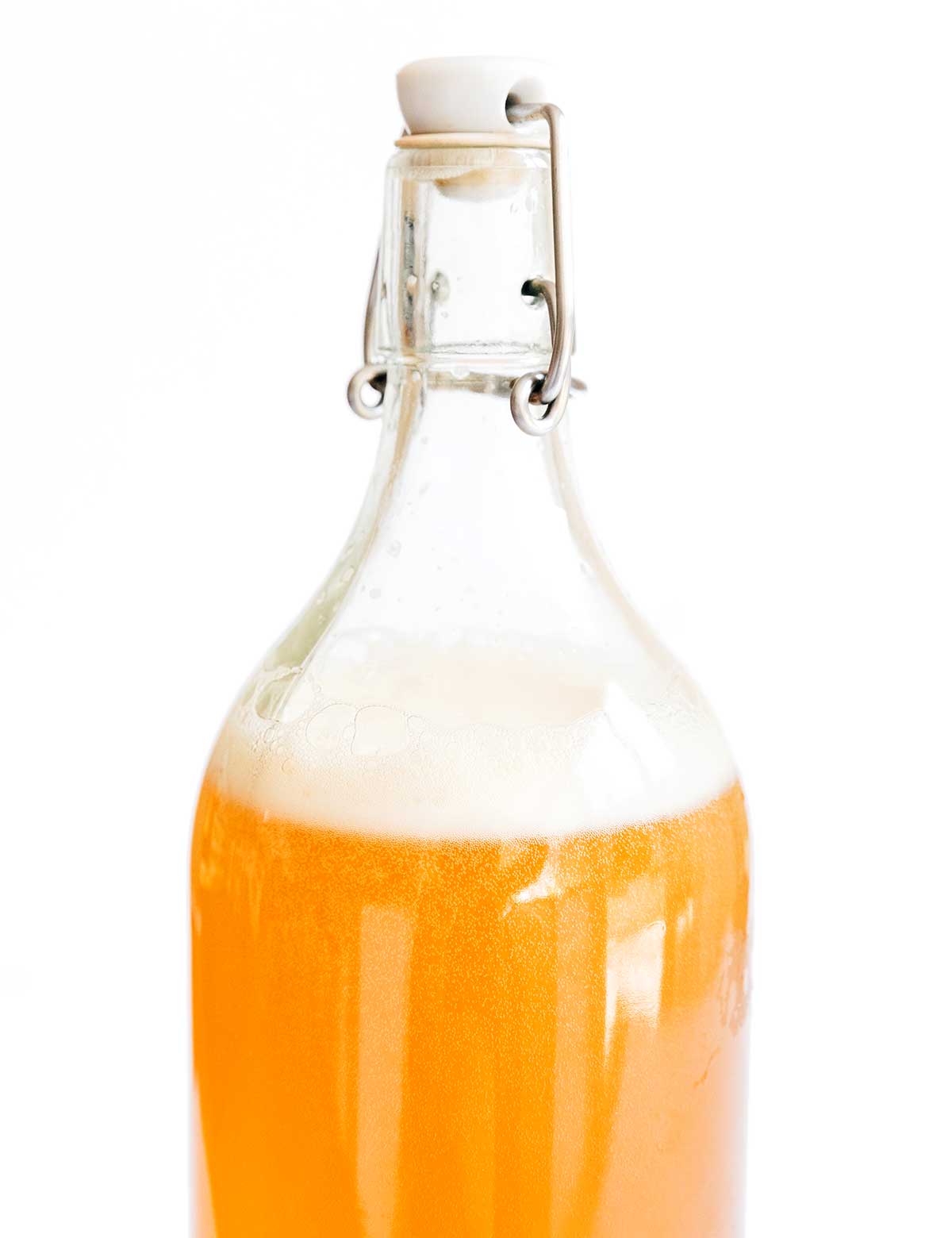
Flavor Variations
Tepache is incredibly versatile in the flavors you can add to it! Here are some ideas to get you started:
To the first fermentation, you can add 2 thumbs of fresh sliced ginger (highly recommend), whole cloves, cinnamon sticks, chilis, pineapple flesh, or even diced mango. Just be sure to submerge all ingredients fully in liquid to prevent mold.
To the second fermentation, you can add virtually any fruit juice or fruit puree. Get some ideas from our kombucha flavors!
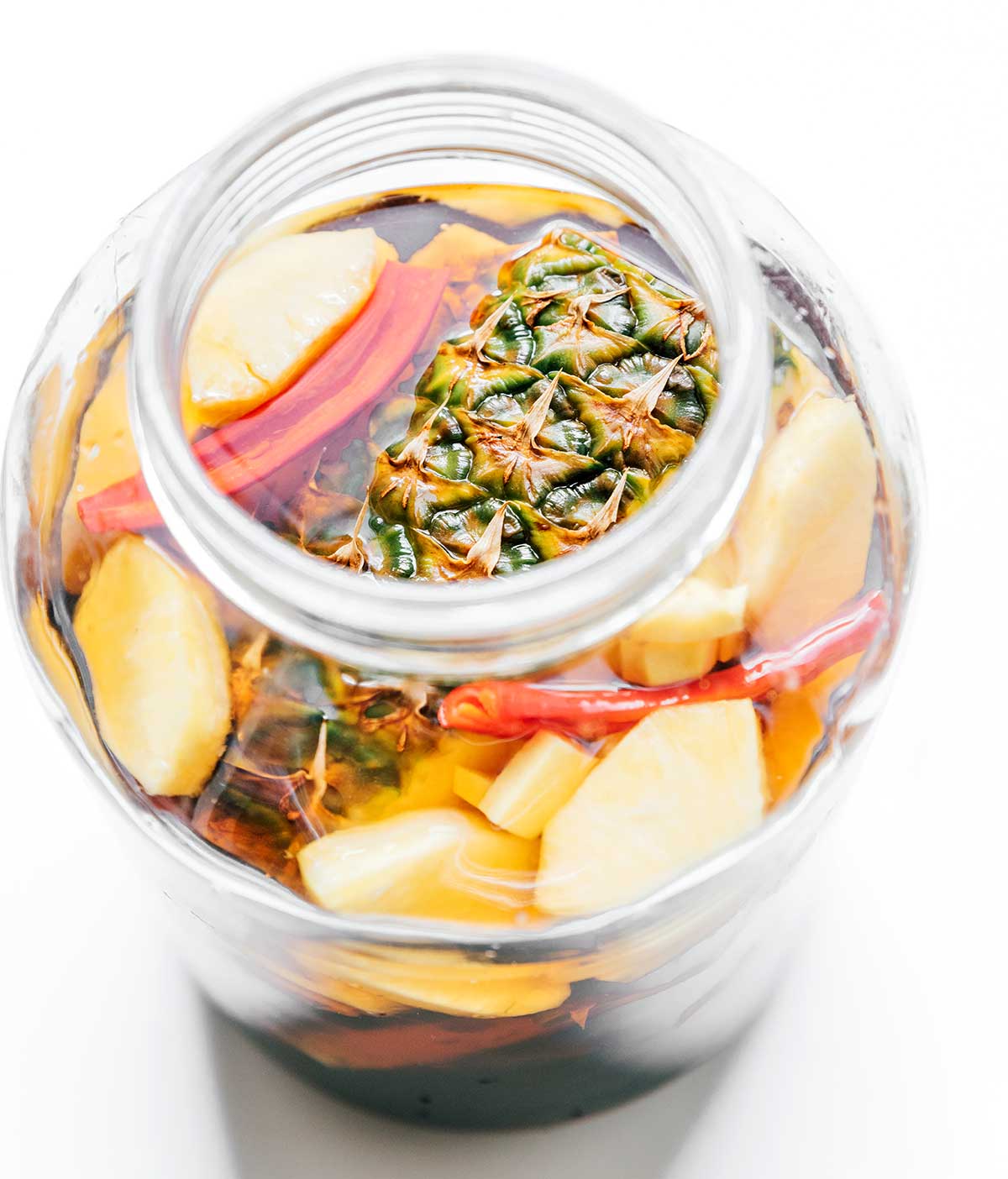
Tepache FAQ
Most fermentations involve a bit of trial and error, so it’s normal to have questions along the way! Here are some frequently asked questions (but feel free to drop a comment below with questions not answered here!).
If your tepache isn’t bubbly, it is likely because the yeast aren’t working well. This could be because you washed or submerged the pineapple in hot water (which would kill the yeast), or because your pineapple wasn’t ripe enough (meaning there wasn’t much yeast on it to begin with). If your tepache does not bubble in the first fermentation, consider starting over. If it did bubble in the first but not in the second fermentation, add a little sugar or juice to the bottles to give the yeast something to eat.
Tepache has an alcohol content of about 2% ABV, though this can be less if you let it ferment for a shorter time, or more if you let it go longer or are in a warmer climate. Test your tepache alcohol level with this tool.
The main benefit of tepache are the probiotics, which promote a healthy gut and digestion. More on probiotics here.
Store finished tepache in a sealed container in the refrigerator for up to a year. As with most fermentations, tepache will last virtually forever due to the acidity. Over time the flavors will continue to develop towards yeasty, but a properly made tepache will last for a long, long time!
When made with clean supplies and when ingredients are submerged in the liquid while fermenting, tepache is safe to drink. The sugar in the liquid prevents bacterial growth until the yeast acidifies the drink, then the low pH takes over as an antibacterial protection. If you notice any mold growing, or detect any off-flavors or smells, throw away the whole batch and clean your supplies well before trying again.
Tepache ferments between 60-85°F (16-29°C), though for the most delicious tepache, aim for a temperature range between 75-80°F (24-26°C).
It is best to avoid prolonged contact with metal, as the acidity in the tepache can interact with the metal. Aim for glass or ceramic jars and bottles when brewing.
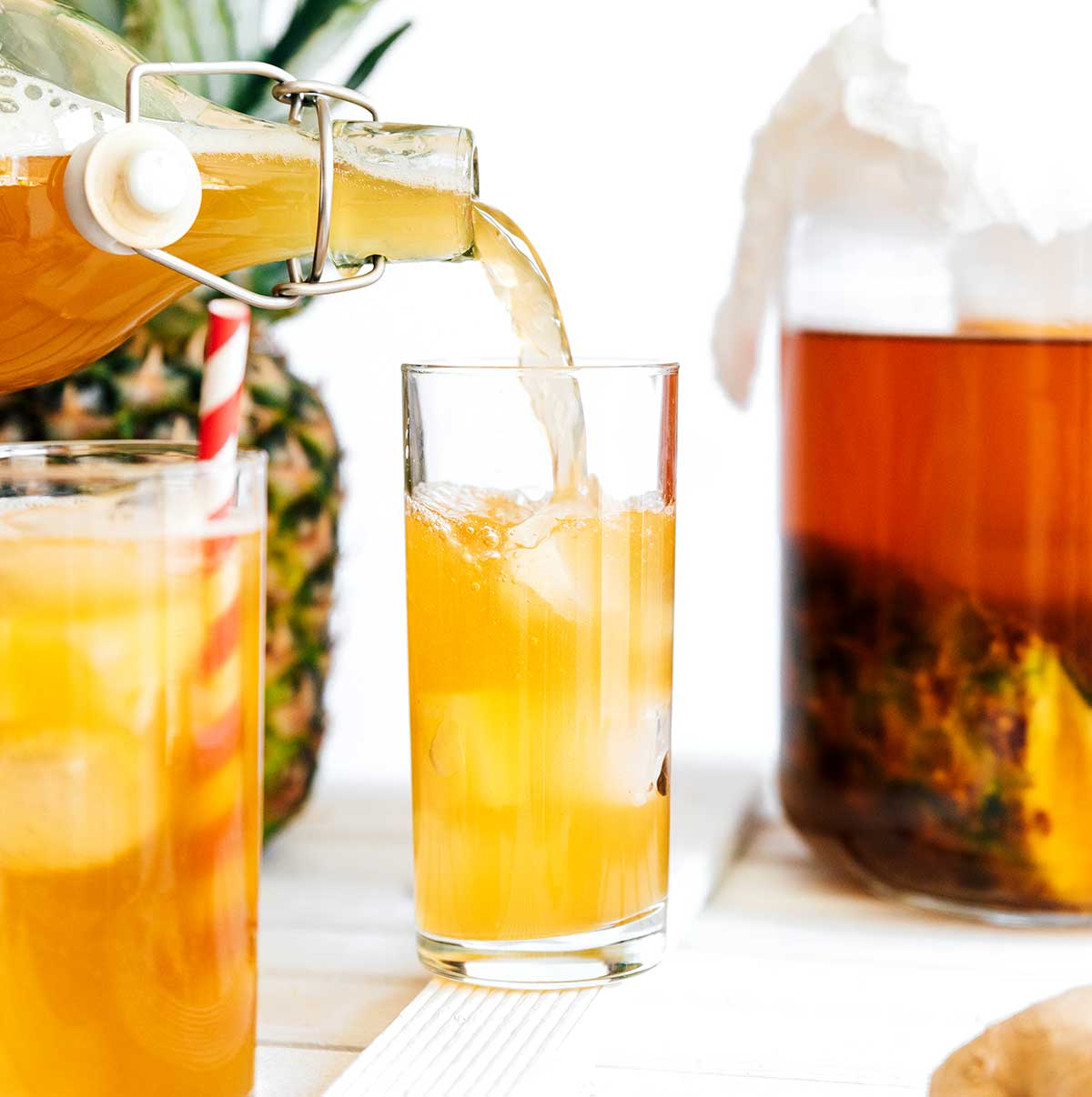
Be sure to try our other fermentation projects, like kimchi, kefir, Greek Yogurt, kombucha, and sauerkraut!
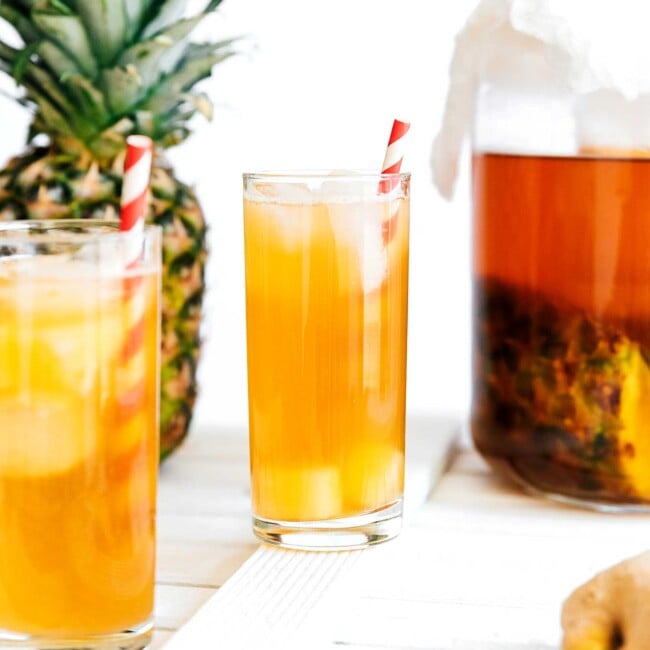
Ingredients
- 1 ripe pineapple
- 1 cup light brown sugar 200 g, or 1 large cone piloncillo
- 8 cups water 1.9 L
- Optional: 2 thumbs sliced fresh ginger, ½ red chili, 1 cinnamon stick, 3 whole cloves
Instructions
- Cut: Remove the crown and base of the pineapple, then rinse the body of the pineapple with cool tap water to remove potential pests or dirt. Cut the peel from the pineapple in big chunks, leaving about ½ inch of the pineapple flesh on the peel.
- Assemble: Add sugar (or piloncillo) and 1 cup of the water to a clean, large glass or ceramic jar, stirring well to dissolve sugar. Add optional flavors and cover with pineapple rinds, then add remaining water. Submerge all ingredients in the liquid to prevent mold by weighing it down using either a glass, ladle spoon, or fermentation weight.
- Ferment: Cover with a clean dish towel or a few layers of paper towels, then secure with a rubber band. Set somewhere dark and room temperature (ideally 75-80°F, 24-26°C), letting it ferment for 1 to 3 days.
- Drink or Bottle: The tepache is finished when you see many small bubbles on top and it tastes how you want it to (test by drawing some out with a paper straw, using your finger to keep the tepache in the straw). Either refrigerate and drink the tepache as is, or carbonate it in the second fermentation.
- Second Fermentation (Optional): Funnel the liquid into fermentation-grade bottles, leaving about 2 inches free at the top of each bottle. Set somewhere room temperature and dark, then allow it to ferment for another 1 to 3 days. After 24 hours, pop open a bottle to see how carbonated it has become and to gauge how much longer they will need. When the tepache has reached a carbonation level that you like, transfer the bottles to the refrigerator to stop the fermentation.
Tips & Tricks
- Reuse the pineapple peels for another 1 or 2 rounds after your initial fermentation. There is still plenty of yeast on them!
- Blast zone: Carbonating tepache in the second fermentation does involve pressure build up inside the bottles, which is why I recommend bottles specifically made for fermentation. As with any second fermentation, there is a risk of bottles exploding, so check on your bottles regularly and move them to the refrigerator when done.
- Store finished tepache in a sealed container in the refrigerator for up to a year. As with most fermentations, tepache will last virtually forever due to the acidity. Over time the flavors will continue to develop towards yeasty, but a properly made tepache will last for a long, long time!
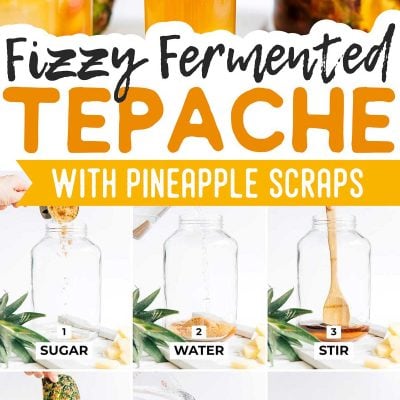
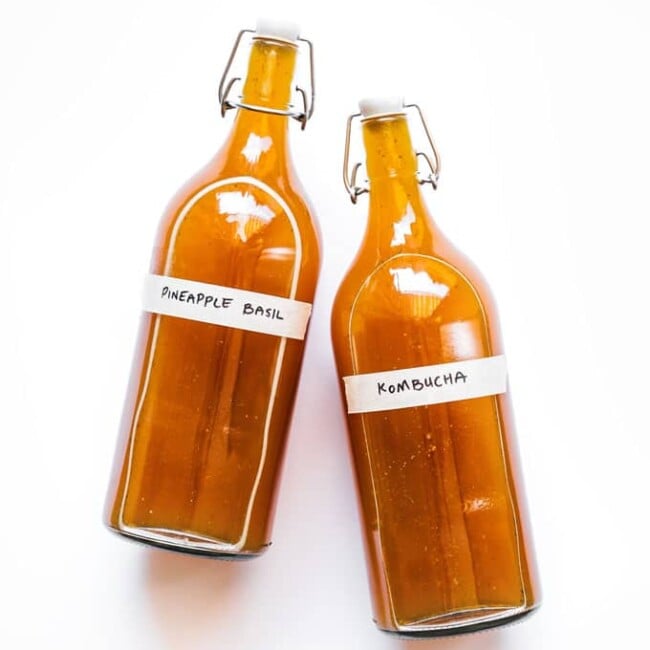
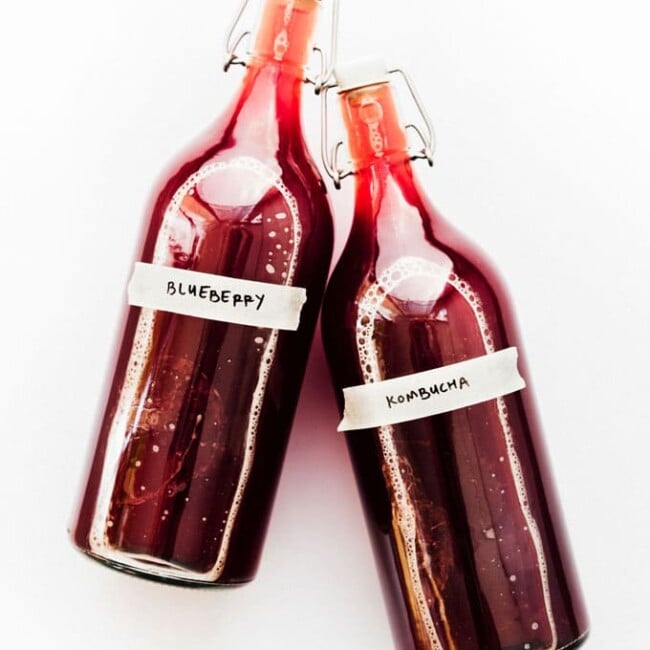
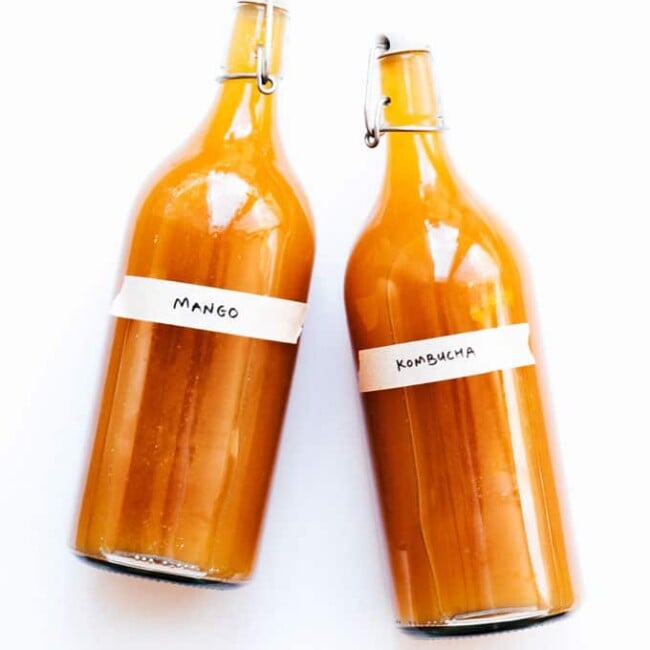

Muriel says
If you have fresh pineapple, but have already discarded the peel – can you still make Tepache using the pineapple fruit?
Sarah says
Great question! You will need the peel – this is where that natural yeast hangs out, and what you will need to kick off the fermentation. 😀
Heather says
My Tepache never bubbled and smelled “funky”! I washed in lukewarm water as suggested and the pineapple was nice and ripe. My house is chilly so I gave it 2 days for the first ferment. It smelled weird and had no bubbles. I checked again days 3 and 4 and it was a bust! This seems so easy, if I can get it to work! I’ll try again once I buy another pineapple. The rind just goes into the compost anyway so why not make something from it! Any suggestions in the meantime?
Sarah says
Hi Heather! Did you give it a taste to see if any flavors were developing? If your house is chilly, it could take even longer than 4 days (up to about a week). But with that said, a super chilly house will prevent any fermentation from happening. Can you try to find a warmer area?
And try rinsing with cool water rather than lukewarm, just in case the yeast were impacted by that. Happy brewing!
Tim says
Organic pineapple is important to start with as it will have more natural yeast on it than a conventional one. If your local tap water is heavily chlorinated then that could be impeding the development of a healthy yeast culture. Use filtered or bottled water in that case. Once you get a successful tepache batch going you can save 4-8 oz of your yield in a jar in the fridge and use it to get a new batch going quicker. It’s called backslopping, all the kids are doing it. With a healthy starter like that you can use conventional pineapple rinds, just the pineapple flesh or start with other fruit. You can also use that yeast culture to start ginger beer or any other booze ferment, though it will always be a unique ‘bug’ that came from pineapple yeast.
Sarah says
Thanks for all the tips, Tim! “All the kids are doing it”, hahaha 😀
Eileen says
Hi, I just made my first tapche. But I didn’t submerge the pineapple fully in the liquid. After 3 days the top pineapples smelled a bit rotten and a bit blackish. But I tasted the tapche and it taste ok.. never drank one before but it taste like sweet pineapple vinegar soda. It actually taste kinda nice. Is it still safe to drink?
Sarah says
Hi Eileen! If there are any traces of mold (so the blackish stuff you see, especially if it’s fuzzy) then I wouldn’t drink it. You really have to make sure the peel is fully submerged or mold will develop (happened to me every time the peel was exposed!)
Suzanne says
I think I need some help. I haven’t had tepache before but I don’t like the flavor. I thought it would be more like the kombucha, which I love. I’m wondering if I did something wrong.
The temperature is around 70 degrees. I started with 3 days then did a second batch with the same peels for 2 days. Still not loving it. Does it need to go longer? It seems very yeasty.
Sarah says
Hi Suzanne! Tepache can range from anywhere between sweet like pineapple soda and yeasty like beer. If it is very yeasty then it likely went for too long. Try tasting after just 24 hours and go from there!
Andrea Stevens says
Hi!
I just made this morning but my jar only held 4 1\2 cups of water. Will it be ok for this batch? I’ll get a bigger jar this weekend for the next try. Thank you!
Sarah says
That should be fine, I would just scale down the recipe proportionally 😀
Andrea Stevens says
Thanks for the quick response!
Unfortunately, I added the sugar before I realized the jar wouldn’t hold a lot. Should I let it sit longer because of the extra sugar?
Sarah says
You could try that and see what happens! It will indeed more time to process through that sugar, and the flavor may be different than it would with less sugar.
Angela says
Will it work if I had refrigerated the pineapple?
Sarah says
That should be fine, Angela! 😀
Roha says
If I added baker’s instant yeast, is it bad to drink the beer given the yeast is still active in the final beer that has a relatively low alcohol content?
Sarah says
Hi Roha! I’m really not sure, unfortunately. I’m not sure how bread yeast would work with this. If you want to try to make this more alcoholic, I would recommend champagne yeast (but have not personally tried it so can’t be sure).
Aya Burt says
Hi! So I made my tepache. It took three days and just saw some bubbles forming but also a clear film formed on the pineapple. Is not smelly or gooey when you touch it it is like a wet napkin kind of texture. Is that normal? Is it safe to drink? The smell And taste are perfect I’m Mexican and grew up drinking it so I’m familiar with the smell and taste but I had never tried making it. Than you for your help!
Sarah says
Is the layer dry, fuzzy, or off-colored? If the taste and smell are correct then I don’t think it’s mold, though I haven’t had something like this happen before so I can’t be for sure.
Jeanne says
I wanted my latest batch to be less sweet, so left it longer. It now tastes completely like vinegar! Is there anything I can use this for Or should I just toss it?
Sarah says
Ah shoot, sorry to hear it, Jeanne! Those fermentation can be so temperamental. You could try mixing it 50/50 with ginger ale, sprite, or carbonated water!
Helen says
I love the natural recipe, what did you do with the pineapple?
Sarah says
I love it in smoothies or kombucha! 😀
Laura says
I made ginger pineapple jam!
Gabriel Bourgogne says
hello there ! the recipe is simple to make and everything but there is a smell of rotten egg…is that normal ?
Thank you
Sarah says
Hmm rotten egg smell isn’t normal. It should smell yeasty, like beer or bread. Are there any traces of mold on the surface? And is your pineapple fully submerged?
J. M. Palmer says
That’s also a sign the yeast is distressed. This happened with my ginger beer and I have tried to figure out if it was too much sugar or not enough oxygen. I still don’t know…
Tim says
I’m so excited that people are making tepache! Thank you for putting this recipe out there and spreading the gospel! I can second adding the chili and ginger. I definitely second the cloves and cinnamon too, but they are kind of a must so I feel less emphatic about them. Other things to play with are black peppercorns, whole cardamom pods, cumin seeds and grains of paradise.
1 to 3 days for the secondary ferment sounds like a suicidal length of time though! I’d cut it at 6-12 for a first batch using only the wild yeast on the pineapple. I lost a lot of tepache the first few times I made some by letting it carbonate over night 🙁 . I use an heirloom starter from my previous batches (going on 8 generations of tepache now I think?) and now it’s so vigorous that 2 days first ferment is almost too long at 72 degrees and more than 2 hours secondary ferment is way too much pressure built up. Now that I’ve gotten the hang of it, I prefer this because it’s much quicker and more predictable. I usually let it go too long now and get very dry then I add simple syrup or pineapple juice as I’m bottling to nail the sweetness that I want and play with interesting added flavors. It also ensures a higher alcohol content (like 2%…)
Of course everything depends on the strength of the ferment, how much sugar is left in the mix at bottling and the temperature. But that’s my 2 cents about the 2nd ferment at bottling.
BYaruhanga says
Can i add potassium sorbate to preserve the recipe
Sarah says
I can’t say for sure as I’ve never tried it, sorry about that!
Chris says
Hi, I live in northern USA and pineapples would have to be imported. Even if organic wouldn’t there be a lot of crap on the peels, being that they are so three-dimensional? How might this affect the kombucha and myself? Is there a way to rinse them without losing any yeast? Thank you
Sarah says
Just give them a good rinse with cool water! I usually look for any visible dirt or nasties, but haven’t scrubbed or done any deeper cleaning than that.
Trickydicky says
Hello Sarah. This recipe looks amazing. I have brewed a lot of beer in the past, some from kits using wort, others from boiling hops and using more traditional methods. I must say that the kits are easier, and far less smelly, as boiling the hops gives off an awful stench that lingers for days.
I wish I had known this recipe when I lived in Glass House Mountains, north of Brisbane. I was there for 14 years and tidally surrounded by vast farms full of organic pineapples. I knew a lot of the owners and could always have as much as I wanted. I live back in the U.K. now, so no such luck.
I did have one question about your instructions above. You mention putting a tea towel, or tissues, over for top to allow oxygen in. My understanding was that fermentation was an anaerobic process. Have I missed something in my understanding? Is something else going on here?
I have another tip for anyone living in cold climates. When I was living in Australia the summers were ridiculously hot (daily temps L: 20°C, H: 40°C), and the winters would be a little less hot (L: 15°C H: 27°C). This made it very difficult to brew anything unless you lived with the aircon on constantly to maintain a steady and adequate temperature for the yeast. In the U.K. I find that buying one of the brewers electric heater belts, or pads does the job really well. If I am brewing up a larger batch of something (40 pints or more) I have found that using a good quality tropical fish tank heater, one that has accurate temperature adjustment, to be an excellent temperature regulator. The fish tank heaters are also far cheaper than buying specialised brewing specific ones.
Thanks for the great recipe. I can’t wait to try it.
Sarah says
Nope, it’s aerobic! 😀 You only seal it airtight when you want to build carbonation. Happy brewing!
Muriel says
Can you use natural/unrefined cane sugar or honey?
Sarah says
I’m not sure about unrefined cane sugar but would not advise using honey which can contain different strains of bacteria and be harmful. From having brewed kombucha, I don’t think the unrefined cane sugar would work well either, but you can always give that one to go!
Helen says
Hi There
Can I put the pineapple skins in a plastic container?
Thanks very much.
Sarah says
I don’t recommend using plastic in fermentations because it is porous and can house bacteria. Glass will be your best bet!
MARTIN says
Good day,
My question is about reusing the pineapple rinds.
When reusing the rinds, do I add Sugar to the mixture again or only water?
Thank you for sharing this recipe!
Sarah says
Add sugar! 😀
Quinne says
There’s no way for me to get an organic pineapple. Do you think it would be okay to use a non-organic one if I wash it really well? I’m so excited about this recipe and would love to try it!
Sarah says
Yep that should be fine! Just don’t use hot water or soap, which would remove the good yeast on that pineapple skin!
Duane says
If you can’t get organic pineapple and want to try to make this anyway then do indeed clean your nonorganic pineapple well. I would recommend backslopping with other tepeche and if you don’t have any another technique is to pour some of the clear liquid that forms on top of yogurt that you have stored in the refrigerator. I have boosted slow batches with the clear yogurt fluid and it has worked quite well. I have read that you can also backslop with kombucha if you have some. Just tricks I have picked up from other tepeche sites online. It is all good.
Yolanda says
Hello, is it possible to juice the pineapple fruit and use that as a portion of the water amount along with the peels?
Sarah says
I haven’t tried this, but I suppose you could! 😀 Would love to hear how it goes if you try it out!
Lisa says
Will have to try this!
However, fermentation is an anaerobic process. That’s why you weight down your produce to keep it under the surface of whatever salt or sugar brine you are using.
Yeast is digesting the sugars and the CO2 is a byproduct of that process.
Marie Smeets says
I read somewhere that you can add fresh blueberries & raspberries to the pineapple too. I tried it but after 3 days, i am not getting any foam yet. Smeels yeasty tho. Is it bad or is it still fermenting?
Sarah Bond says
Probably just fermenting! Usually bad tepache will have visible signs of mold or a foul odor.
Jordan says
I made the tepache and it’s turned out beautifully! I am a bit worried though. I bottled it today after straining through cheese cloth and closed them for the second fermentation. I decided to check it 12 hrs later and it fizzed all over. One, did I lose all of my carbonation now? And two, will it explode now if i reseal it and refrigerate it?
Sarah Bond says
I would try “burping” it every few hours to let out that excess carbonation in the future! But in the fridge the fermentation will slow down so it shouldn’t be as explosive in there. Happy it turned out so well otherwise! 😀
Bonny says
Very clear directions. I have made this a few times and it turned out great. If you can get ahold of a pink pineapple, they are sweeter. I’ve used brown sugar and pincello and they both worked out the same.
Mike says
Have made this many, many times over this Summer. Gotta do the 2nd ferment as it’s so much better. I do two days 1st ferment and then two days 2nd ferment. Really perfect for us. It has worked perfectly every time. Oh, and I always use Mexican cone sugar. Thanks! A great recipe and guide you have here!
Al says
How long does the tepache last after the FIRST fermentation? And does it have the healthy gut stuff (probiotics) without the 2nd ferment?
Sarah Bond says
It has virtually the same benefits without the 2nd fermentation – just won’t be bubbly! It can be stored indefinitely in the fridge 😀
Kairnk says
Can I use teacher in secondary kombucha fermentation?
Sarah Bond says
I haven’t tried it, but I think you probably could use tepache in the 2nd ferm!
Michelle says
Hi,
I made this after watching Brad on Bon Appetite and finding your site. I had good fermentation on my first try and after straining it for the second fermentation in bottles it has a thick slimy consistency. What would be causing this? The flavor is right but the slime is off-putting!
Sarah Bond says
Isn’t Brad the best?! Tepache is a “wild” fermentation, meaning we’re *hoping* the right yeasts get to work on fermenting. Sometimes the balance of yeasts and bacteria can get off a bit, which would cause the sliminess. It’s very likely still safe to drink, but I’d say just try again with a clean container to reset your brew!
Rose Leal says
Back in 1950 my grandma started the drink people would line up to get her beer. Pineapple beer
emily says
Hello,
I just opened up my tepache after 4 days and I was surprised to find that it wasn’t a watery thin liquid. Instead, as I was removing the pineapple peels, a viscous, syrupy liquid was flowing off each piece. Likewise, when I poured a portion into a mug, it was thick and bordering on gelatinous.
Can you help me troubleshoot?
Sarah Bond says
This is probably from an overgrowth of the wrong bacteria type (Pediococcus). Tepache is a “wild fermentation”, meaning really any bacteria and yeast *can* be present, which is probably why this happened. I would say just try again after cleaning everything well!
Jane says
Do you ever use this to make cocktails or is it better drinking on its’ own? I would think the fermentation might yield a small amount of alcohol. Is that correct? I’ve used your kombucha recipe in the past and it was wonderful just takes a bit of getting used to the ‘look’ 🙃 of the end result
Sarah Bond says
There is a small amount of alcohol in this, yes! Probably not enough to be considered an alcoholic beverage. I do love using it as a cocktail base though! 😀
Prakash says
Simple but thorough for any level beginner to follow!
Shai says
Can I put a lot of pineapple peel in one jar? And how many grams of sugar will be needed?
Sarah Bond says
Do the peel of 1 pineapple and 200 grams of sugar 🙂 You can add a little more peel if you have it, just be sure everything is submerged in the water.
Barbara says
Thank you for the well written recipe; especially the options with mango or other fruit for different flavour.
Pat Finn says
Super glad that I found this! I have found that when making tepache that after 2nd fermentation that my tepache reaches a very fresh beer like level of carbonation that is almost my target. The problem or my question is that I have noticed after it reaches this stage, I put it in the fridge and then when I open it, the carbonation level has regressed almost to a soda like level of carbonation. Is it losing its carbonation when I open it to test at the end of 2nd fermentation? would it keep its carbonation if I did not open/burp it to test before refrigerating it?
Sarah Bond says
Yep it would probably keep more carbonation if you didn’t burp it! Chilling it does tend to make it slightly less carbonated though.
Eisya says
Hi. By doing the 2nd fermentation.. does the alcohol content increase?
Sarah Bond says
Yes, the longer you leave it to ferment (whether in the initial or the second fermentation), the more alcohol will be produced.
Myrna says
Tried to read through the comments for this answer, but did not see it yet. I am just trying this recipe. After first fermentation, it does taste pretty delicious. But I do want the carbonation. So I’m doing my second fermentation now. I only have two of the bottles to use. So as a result, I have about a quart left of first fermentation. If I put that in the refrigerator for now, can I pull it out later for second fermentation in the bottles once they’re emptied? If not, I will just consume it as is. Or if I’m understanding another comment correctly, I can save it to boost another fermentation with pineapple meat and/or skins. Is that correct? I love this recipe by the way! I also have a bit of a tip. The only thing I had to put that much liquid into for the first fermentation was a mason jar type drink dispenser. So when the first fermentation was done, I just had to open the tap at the bottom into a strainer over a bowl. That made it extremely easy to stain it! I love to improvise!
Sarah Bond says
You have it all correct! You can either pop it in the fridge then do the second fermentation later, drink it as is, or use it to boost another batch.
And thanks for the tip on the dispenser! I do that for kombucha brewing and it’s SUCH a time/mess saver! 😀
Tina says
This was amazing and similar to making kombucha or ACV.
Instead of using a weight, I took a tip from making ACV and used a plastic or wooden spoon to push down the pineapple each day and then recover until it was done.
Myrna says
This is my third time making this recipe. First time, wonderful! Second time, I messed up with additives I think. I didn’t like the flavor but it worked other than that. This time, the consistency is as thick as honey! Why is that? Do you know? Thank you!
Sarah Bond says
Oh strange! It sounds like the yeast are just acting differently this time. Is the temperature different?
Capri says
My 1st batch was delicious but the 2nd and 3rd batch turned to slime. ????
Sarah Bond says
I’ve heard of this happening! It’s basically got an overgrowth of the wrong type of bacteria (pediococcus bacteria). Start a new batch with fresh peels and a clean container!
Elizabeth Johnson says
Kombucha lowers in sugar the older it gets so 8oz can go from 20g to 2 in a couple weeks. What about tepache?
Sarah Bond says
Same process with tepache! 😀